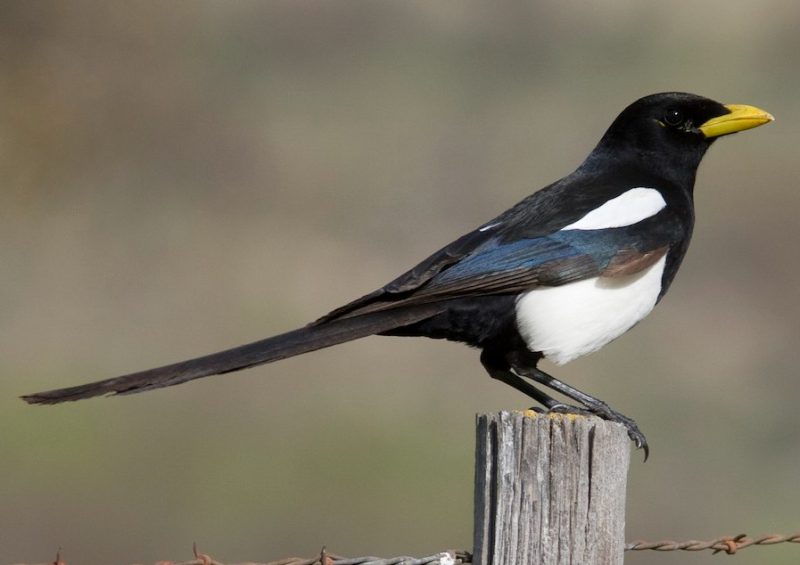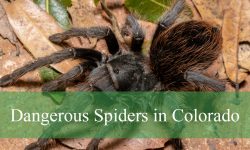Magpies are among the most striking and intelligent birds in North America, but in California, only one species exists: the Yellow-billed Magpie (Pica nuttalli). Endemic to the state, this bird is instantly recognizable by its bright yellow bill, glossy black-and-white plumage, and long iridescent tail. Its limited range makes it a unique and special part of California’s avian diversity, drawing attention from birdwatchers and nature enthusiasts alike.
The Yellow-billed Magpie is remarkable not only for its appearance but also for its complex social behaviors, adaptability to diverse habitats, and interactions with both humans and other wildlife. Observing this species provides insights into its intelligence, territoriality, and cooperative behavior, making it one of the most fascinating birds in the state.
In this article, we will explore the Yellow-billed Magpie in California, covering its identification, behavior, diet, habitat, breeding habits, and the best places and times to watch it. By understanding this singular species, birdwatchers can enjoy meaningful encounters and deepen their appreciation for California’s unique wildlife.
Yellow-billed Magpie Species Overview

The Yellow-billed Magpie (Pica nuttalli) is endemic to California, meaning it is found nowhere else in the world. Its striking appearance makes it instantly recognizable. Adults have a bright yellow bill, glossy black head, back, wings, and tail, with a subtle iridescent sheen that reflects blues and greens in sunlight. The belly and parts of the shoulders are white, creating a sharp contrast that enhances its visual appeal.
Measuring about 17 to 19 inches in length, with a wingspan ranging from 21 to 24 inches, the Yellow-billed Magpie is a medium-sized corvid. Both males and females look similar, though males tend to be slightly larger. Juveniles have duller plumage and grayish bills, gaining their characteristic yellow coloration as they mature.
The Yellow-billed Magpie is closely related to the Black-billed Magpie (Pica hudsonia) found in other western U.S. states, but the yellow bill and restricted California range make it a unique species. Its limited distribution makes it particularly interesting to ornithologists, as it has evolved in relative isolation, adapting to the climate and ecosystems of central California.
Physical Characteristics and Identification
Yellow-billed Magpies are visually striking birds. Their black plumage covers the head, neck, wings, and tail, often showing subtle iridescent highlights of green and blue. The white underparts, especially the belly and shoulder patches, provide a stark contrast. The most distinguishing feature is the yellow bill, which is longer and slightly curved, making foraging and food handling efficient.
The long tail, which accounts for nearly half of the bird’s total length, aids in balance and agility during flight. Strong legs and feet allow the magpie to walk or hop across the ground in search of insects, seeds, or other food items. Their eyes are dark brown and expressive, conveying intelligence and vigilance.
Juvenile Yellow-billed Magpies are less vivid in coloration. Their bills are pale gray, and the black feathers on their wings and tail are less glossy. Over the first year, they acquire the characteristic bright yellow bill and iridescent black feathers. Observers can often distinguish juveniles from adults based on subtle differences in plumage and behavior, such as less confident flight or tentative foraging.
Behavior and Social Structure
Yellow-billed Magpies are highly social birds, often observed in pairs or family groups. Outside the breeding season, they may gather in small flocks, sometimes numbering dozens of individuals. These birds exhibit complex social behaviors, including cooperative foraging, territorial defense, and intricate vocal communication.
Their vocalizations are diverse, ranging from harsh chattering to melodic warbles, often used to communicate with mates, family members, or neighboring magpies. They also engage in playful behaviors, such as aerial acrobatics or manipulating objects, reflecting their high intelligence.
Territoriality is pronounced, especially during the breeding season. Pairs vigorously defend nesting areas from intruders, often using calls and visual displays to deter rivals. Despite their boldness, Yellow-billed Magpies are cautious around humans and may retreat if threatened, though they can become accustomed to observers who maintain respectful distances.
Feeding and Foraging Habits
Yellow-billed Magpies are omnivorous and opportunistic feeders. Their diet includes insects, small mammals, eggs, carrion, seeds, grains, fruits, and occasionally human food scraps. They are known to cache food, storing surplus items for later consumption, particularly during the dry California summers when resources can be scarce.
Foraging usually takes place on the ground, where the magpie hops or walks, probing soil, leaf litter, and grasses for insects or seeds. They are intelligent problem-solvers, capable of manipulating objects or using their bills to access hard-to-reach food. Occasionally, they may raid nests of smaller birds, a natural behavior that provides additional protein.
Yellow-billed Magpies are also efficient scavengers, cleaning up carrion and leftover human food, which contributes to ecosystem health. Their adaptability in diet is a key reason for their survival in both natural and human-modified environments.
Habitat and Distribution in California
The Yellow-billed Magpie is endemic to central California, primarily found in the Sacramento and San Joaquin valleys, as well as the surrounding foothills and edges of the Sierra Nevada. Its habitat includes oak woodlands, riparian corridors, open grasslands, and agricultural fields with scattered trees. Unlike the Black-billed Magpie, which occupies broader ranges in other western states, the Yellow-billed Magpie is highly localized and does not migrate.
These magpies favor edge habitats—areas where open fields meet tree lines or shrubbery—allowing them access to both cover and feeding grounds. In urban and suburban areas, they exploit parks, golf courses, and residential gardens. Nesting occurs in tall trees or dense shrubs, typically elevated to avoid predators. Their nests are large, dome-shaped structures constructed from twigs and lined with softer materials.
The limited distribution makes conservation important, as habitat loss or fragmentation can have significant impacts on local populations. Despite this, the Yellow-billed Magpie remains relatively abundant within its restricted range, provided that suitable habitat is preserved.
Breeding and Seasonal Behavior
Breeding occurs from late March through June, coinciding with the abundance of insects and other food sources. Yellow-billed Magpies are monogamous, and pairs defend territories vigorously. Nest construction involves both partners, though the female primarily handles incubation, while the male provides food and protection.
The nests are conspicuous yet elevated, domed structures that protect eggs and chicks from predators and weather. Clutches typically contain 5 to 7 eggs, which hatch after about 17 to 19 days. Chicks are altricial and require extensive parental care, with both parents feeding them insects, seeds, and small vertebrates.
Juveniles fledge after 3 to 4 weeks but often remain close to the nest or within the family group for several more weeks. Seasonal behaviors include flocking outside the breeding season, cooperative foraging, and increased alertness during dry periods when food becomes limited.
Best Places and Times to Watch Yellow-billed Magpies
For birdwatchers, the Sacramento Valley offers some of the best opportunities to observe Yellow-billed Magpies. Open fields, agricultural lands, and scattered oak trees provide ideal viewing conditions. The Sierra Nevada foothills are another excellent location, where magpies use oak woodlands and riparian zones for nesting and foraging.
Early mornings and late afternoons are typically the most active times for magpies. During the breeding season, observers can witness territorial displays, nest building, and feeding of chicks. In the fall and winter, magpies may gather in flocks, providing opportunities to study their social interactions. Urban parks, golf courses, and suburban gardens with large trees also attract magpies, although the birds may be more cautious around humans.
Interaction with Humans and Conservation
Yellow-billed Magpies have adapted well to human-altered landscapes but remain dependent on natural habitats for nesting and foraging. They are considered a species of least concern, yet their restricted range makes them vulnerable to habitat loss, wildfires, and environmental changes.
Human interaction can be positive when observers respect their territory and avoid disturbing nests. Birdwatchers can support conservation by monitoring populations, reporting sightings, and protecting oak woodlands and riparian habitats essential for their survival. These intelligent and charismatic birds provide a unique opportunity to connect with California’s wildlife while promoting ecological stewardship.
FAQs About Yellow-billed Magpies in California
What species of magpies are found in California?
Only the Yellow-billed Magpie (Pica nuttalli) is native to California. This species is endemic to the state and does not naturally occur elsewhere.
How can I identify a Yellow-billed Magpie?
They have a bright yellow bill, glossy black head, back, wings, and tail with iridescent highlights, and white underparts. Their long tail and bold contrast make them easily recognizable.
What is the typical size of a Yellow-billed Magpie?
They measure 17–19 inches in length with a wingspan of 21–24 inches. The tail accounts for nearly half their length, aiding balance and flight.
What do Yellow-billed Magpies eat?
They are omnivorous, feeding on insects, small mammals, eggs, seeds, grains, fruits, and carrion. They may also scavenge human food and cache items for later.
Where are the best places to watch them?
The Sacramento Valley, San Joaquin Valley, Sierra Nevada foothills, and urban parks or suburban gardens with oak trees provide ideal observation opportunities.
What is their social behavior like?
Highly social, they form pairs, family groups, or flocks. They engage in cooperative foraging, territorial displays, and vocal communication.
How do they breed and care for young?
Breeding occurs in spring. Nests are domed and elevated. Both parents care for chicks, feeding them insects and teaching survival skills.
Are they dangerous to humans or pets?
They are not dangerous. Aggression is rare and usually limited to nest defense. Small pets may be at minimal risk during the breeding season.
When is the best time to observe them?
Early mornings and late afternoons are ideal. Spring allows nesting observation, while fall and winter offer views of flock behavior.
Are Yellow-billed Magpies protected?
Yes, they are protected as native wildlife. Their limited range makes habitat preservation crucial for population stability.






